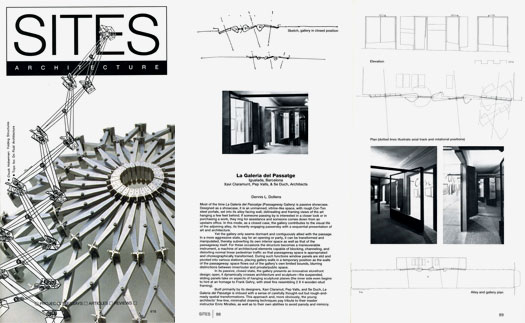Magazine
Sites
GALERIA DEL PASSATGE
(USA)
LA GALERIA DEL PASSATGE
Most of the time La Galeria del Passatge (Passageway Gallery) is passive showcase. Designed as a showcase, it is an unmanned, vitrine-like space, with rough Cor-Ten steel portals, set into its alley-facing wall, delineating and framing views of the art hanging a few feet behind. If someone passing by is interested in a closer look or in purchasing a work, they ring for assistance and someone comes down from an upstairs office. In this mode, as a closed case, the gallery contributes to the visual life of the adjoining alley, its linearity engaging passersby with a sequential presentation of art and architecture.
Yet the gallery only seems dormant and contiguously allied with the passage. In a more aggressive state, say for an opening or party, it can be transformed and manipulated, thereby subverting its own interior space as well as that of the passageway itself. For these occasions the structure becomes a maneuverable instrument, a machine of architectural elements capable of blocking, channeling, and distorting normal linear pedestrian traffic so that passageway space is appropriated and choreographically transformed. During such functions window panels are slid and pivoted into various stations, placing gallery walls in a temporary position as the walls of the passageway: space flows out of the gallery’s own limited bounds, blurring distinctions between inner/outer and private/public space.
In its passive, closed state, the gallery presents an innovative storefront design; open, it dynamically crosses architecture and sculpture-the suspended, sliding panels take on aspects of hanging sculptural planes (the inner side even begins to hint at an homage to Frank Gehry, with steel fins resembling 2X4 wooden-stud framing).
Built primarily by its designers, Xavi Claramunt, Pep Valls, and Se Duch, La Galeria del Passatge is imbued with a sense of carefully thought-out but rough-and-ready spatial transformations. This approach and, more obviously, the young architects’ fine-line, minimalist drawing techniques pay tribute to their master instructor Enric Miralles, as well as to their own abilities to avoid parody and mimicry.

